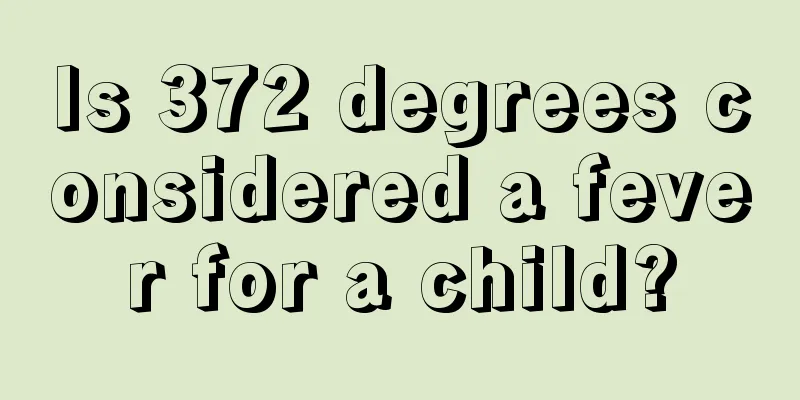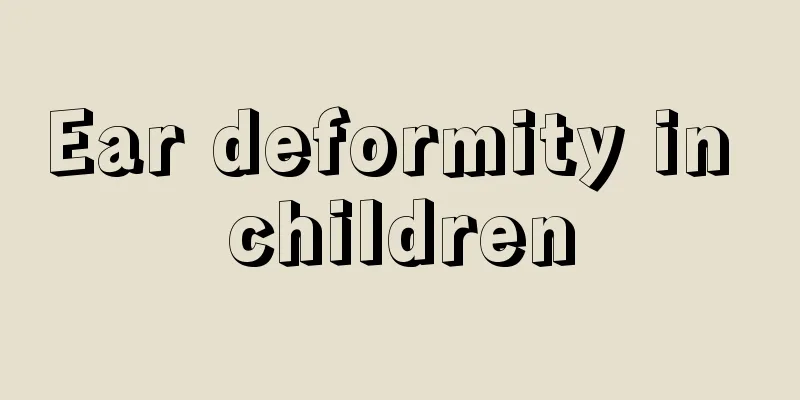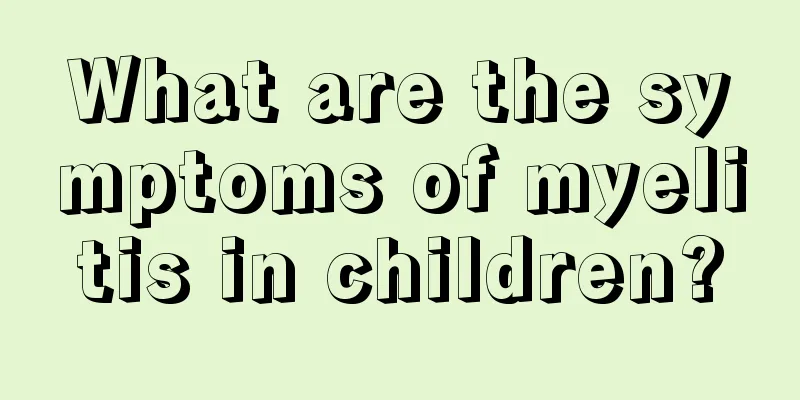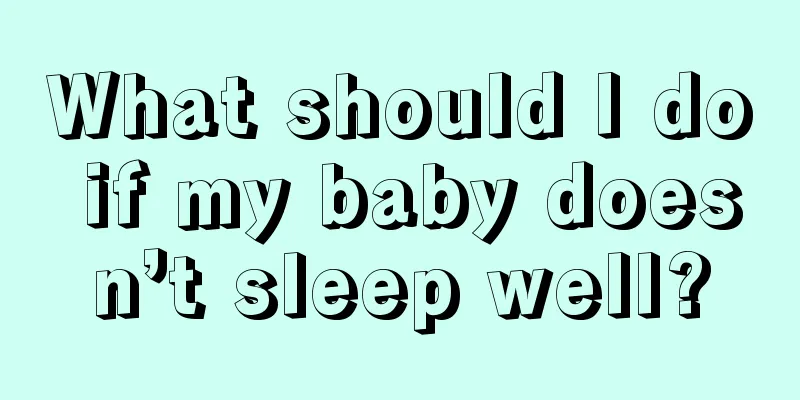Is 372 degrees considered a fever for a child?

|
It is very common for children to catch a cold and have a fever. Generally speaking, if the baby's body temperature exceeds 37.5 degrees, it is considered a fever. At this time, parents should take the baby to the hospital for treatment as soon as possible. Do not deal with it randomly by yourself, otherwise it is easy to delay the disease. 37.2 is not considered a fever, but it is a low fever. Physical cooling methods can be used, such as letting the baby wear less clothes and taking a hot bath. How many degrees is considered a fever for babies The normal axillary temperature of a child is between 36℃-37℃, and it is considered a fever if it exceeds 37.4℃. Under normal circumstances, children's body temperature can fluctuate within a certain range. A body temperature above 37°C is considered a fever. 37.5℃-38.4℃ is a low fever, and above 38.5℃ is a high fever. But every child's physical condition is different, so it depends on the child's physique. If calculated based on rectal temperature, the normal baby's basal body temperature is 36.9℃-37.5℃. Generally, when the body temperature exceeds the basal body temperature by more than 1°C, it is considered a fever. Among them, low fever refers to body temperature fluctuating around 38°C, and high fever refers to body temperature above 39°C. Continuous fever for more than two weeks is called long-term fever. Generally speaking, oral temperature is 0.3℃-0.5℃ lower than rectal temperature, and axillary temperature is 0.3℃-0.5℃ lower than oral temperature. When a baby has a fever, physical methods should be used to reduce the temperature first. If the body temperature exceeds 38.5℃, medication should be used to reduce the temperature. While using medication to reduce fever, physical cooling should also be used. Physical cooling is suitable for babies with high fever and good circulation. You should also pay attention to providing your baby with comprehensive nutrition to improve his immunity. Causes of fever in babies 1. Cold: Both common cold and influenza are the most common diseases for babies. The symptoms of a cold vary, including fever, loss of appetite, gastrointestinal discomfort, diarrhea, and ear, nose and throat problems. 2. Inflammation of the ear, nose and throat: Problems with the ear, nose and throat usually cause inflammation, so there will be redness and swelling. It is a viral infection. Common symptoms include fever, cough, runny nose, redness and swelling of the throat (babies usually don’t want to eat), etc. 3. Roseola: The typical symptom is unexplained high fever (above 39°C), which lasts about 3-4 days, and then a rash appears (the fever will subside at this time). The rash usually disappears slowly without leaving any scars or other complications, so parents don’t need to worry. 4. Vaccination: Many babies have mild fever due to vaccination, but more obvious fever usually occurs after injection of diphtheria, pertussis, and tetanus vaccines. If the baby is unwell or has a cold, it is not suitable to take the baby for vaccination to avoid confusing the symptoms. The observation period for fever after vaccination is 72 hours. If it exceeds this period, the fever is not caused by the vaccine, and parents need to make another judgment. 5. Sepsis: It is a disease in which bacteria invade the blood, usually accompanied by high fever. This disease is highly dangerous and must attract the attention of parents. 6. Urinary tract infection: It is more common in boys and girls under 1 year old. For baby girls, it is usually caused by feces or diapers; for baby boys, it is caused by bladder and ureteral reflux. Apart from the fact that the fever can easily reach above 38.5℃, it is not easy to detect from the outside. 7. Encephalitis and meningitis: Babies between 6 months and 3 years old are most susceptible to this disease. The most typical and threatening symptom is a high fever that can easily reach over 39°C. It is also accompanied by mental fatigue, dull eyes, poor appetite, and even cramps. The only solution is to seek medical attention as soon as possible. Currently the only way to check is to do a spinal tap. 8. Wearing too many clothes, teething fever, summer heat: Fever caused by these reasons is usually short-lived and not dangerous, but it is easy to be ignored by parents. As long as the baby is active and in good spirits and has a good appetite, if the baby has a fever, it may be because he is wearing too many clothes or the indoor temperature is too high. As long as the current situation is improved, overheating will usually no longer be a problem. 9. Gastroenteritis combined with dehydration: It is divided into bacterial (Salmonella) infection and viral (rotavirus) infection. Symptoms include: vomiting, diarrhea, urinary incontinence, decreased appetite, poor spirits, and fever above 38.5°C (combined with dehydration). This disease requires medical treatment and hospitalization, and the patient needs to be given injections and drips to add electrolytes, and his excrement also needs to be specially isolated. 10. Kawasaki disease: Babies aged 1 to 18 months are at high risk for this disease, and the cause is still unknown. There are many symptoms, such as high fever above 39℃-40℃ for several days; red eyes; strawberry tongue, chapped lips, swollen hands, feet and limbs; swollen lymph nodes in the neck; and redness and swelling at the site of BCG injection. |
<<: Did your child break his finger on a toothpick?
>>: Can an 8-year-old child drink honey?
Recommend
What is the cause of dry blood in the child's stool?
Normally, when adults have blood in their stools,...
6 month old baby vomits after eating rice cereal
We know that 6-month-old babies need to add a cer...
Why does a four-month-old baby urinate less?
Some babies will have the problem of less urine, ...
What's going on when a baby blows bubbles from his mouth?
Babies blow bubbles from their mouths because the...
What are the clinical manifestations of precocious puberty?
Due to the fact that the current social life, die...
What fruits can children eat if they have diarrhea in autumn
Autumn is a season with a very dry climate. When ...
My baby has a low fever of 37.5 degrees. What's going on?
Low-grade fever refers to a body temperature betw...
What should I do if my baby’s lower teeth cover the upper teeth? Teach you effective measures
Under normal circumstances, a person's upper ...
What are the symptoms of rheumatic heart disease in children?
Rheumatic heart disease is a very common disease,...
Can children grow taller by jumping on the spot?
The height of today's teenagers generally sho...
How to choose a baby pillow
The baby's body is constantly changing. If th...
Do newborn babies have half-moons on their nails?
It is a common phenomenon for newborns to have ha...
Childhood Obesity
Speaking of obesity, many friends think of middle...
What to do if your baby has a cough, runny nose, or eye mucus
There are many diseases in our lives. Such proble...
What to do if the baby has red spots on his face
Taking care of a baby is something that requires ...









